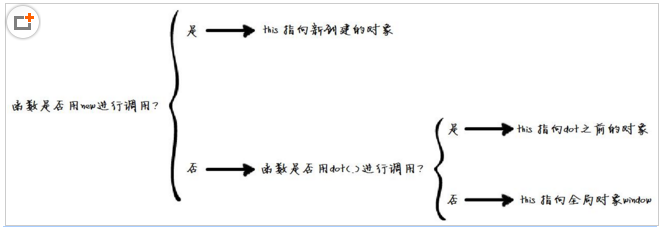js中this指向學習總結
在面向物件的語言中(例如Java,C#等),this 含義是明確且具體的,即指向當前物件。一般在編譯期繫結。
然而js中this 是在執行期進行繫結的,這是js中this 關鍵字具備多重含義的本質原因。下面就讓我們一起來分析一下具體情況。
由於js中this 是在執行期進行繫結的,所以js中的 this 可以是全域性物件、當前物件或者任意物件,這完全取決於函式的呼叫方式。JavaScript 中函式的呼叫有以下幾種方式:
- 作為物件方法呼叫
- 作為函式呼叫
- 作為建構函式呼叫
- 使用 apply 或 call 呼叫
JavaScript this決策樹

根據這個決策樹我們需要進行兩步判斷:
1.函式呼叫是用new進行呼叫的嗎?如果是,則this指向新建立的物件,否則,進入”否”分支;
2.判斷該函式是否是用dot(.)進行呼叫的,如果是,則即進入”是”分支,即this指向dot(.)之前的物件;否則this指向全域性物件window.
demo1:
<!DOCTYPE html>
<html>
<head>
<meta charset="utf-8">
<meta http-equiv="X-UA-Compatible" content="IE=edge">
<title>this指向</title demo2:
對於say方法中的sayA和sayB中的this來說:不是通過new操作符來呼叫的,也沒有通過dot(.)來呼叫,因此this指向window
<!DOCTYPE html>
<html>
<head>
<meta charset="utf-8">
<meta http-equiv="X-UA-Compatible" content="IE=edge">
<title>this指向</title>
</head>
<body>
<script type="text/javascript">
var obj = {
a:0,
b:0,
say:function(a,b){
var sayA = function(a){
console.log(this);//Window
this.a = a;
};
var sayB = function(b){
console.log(this);//Window
this.b = b;
};
sayA(a);
sayB(b);
}
}
obj.say(1,1);
console.log(obj.a+"--"+obj.b);//0--0
console.log(window.a+"-----"+window.b);//1-----1
</script>
</body>
</html>demo3:
<!DOCTYPE html>
<html>
<head>
<meta charset="utf-8">
<meta http-equiv="X-UA-Compatible" content="IE=edge">
<title>面試題</title>
</head>
<body>
<script type="text/javascript">
function Person(name,age){
this.name = name;
this.age = age;
}
var person1 = new Person("lisi",18);
console.log(person1.name);//lisi
var person2 = Person("wangwu",12);
//person2是undefined
// console.log(person2.name);//Uncaught TypeError: Cannot read property 'name' of undefined
console.log(window.name);//wangwu
//Person("wangwu",12)相當於window.Person("wangwu",12)
</script>
</body>
</html>demo4:
apply 和 call 這兩個方法切換函式執行的上下文環境(context),即可以改變this指向。obj1.say.call(obj2,3,3)實際上是obj2.say(3,3),所以say中的this就指向了obj2
<!DOCTYPE html>
<html>
<head>
<meta charset="utf-8">
<meta http-equiv="X-UA-Compatible" content="IE=edge">
<title>this指向</title>
</head>
<body>
<script type="text/javascript">
function Test(a,b){
this.a = a;
this.b = b;
this.say = function(a,b){
this.a = a;
this.b = b;
}
}
var obj1 = new Test(1,1);
var obj2 = {a:2,b:2};
obj1.say.call(obj2,3,3);
console.log(obj2.a+"--"+obj2.b);//3--3
</script>
</body>
</html>demo5:
this的指向在函式定義的時候是確定不了的,只有函式執行的時候才能確定this到底指向誰,實際上this的最終指向的是那個呼叫它的物件.當然這句話不完全準確,因為在不同環境下情況就會有不同。下面我們就來分析一下各種情況。
<!DOCTYPE html>
<html>
<head>
<meta charset="utf-8">
<meta http-equiv="X-UA-Compatible" content="IE=edge">
<title>this指向</title>
</head>
<body>
<script type="text/javascript">
// 這裡的函式test實際是被Window物件呼叫的
function test(){
var name = "lisi";
console.log(this.name);//undefined
console.log(this);//Window
}
test();//這裡相當於window.test();
</script>
</body>
</html>demo6:
如果一個函式中有this,這個函式有被上一級的物件所呼叫,那麼this指向的就是上一級的物件。
這個例子就是指向上一級物件obj
<!DOCTYPE html>
<html>
<head>
<meta charset="utf-8">
<meta http-equiv="X-UA-Compatible" content="IE=edge">
<title>this指向</title>
</head>
<body>
<script type="text/javascript">
var obj = {
name:"lisi",
sayName:function(){
console.log(this.name);//lisi
}
}
obj.sayName();
</script>
</body>
</html>demo7:
物件字面量obj={}
變數obj其實也是window物件的屬性
所以可以這樣來呼叫window.obj.sayName();
如果一個函式中有this,這個函式中包含多個物件,儘管這個函式是被最外層的物件所呼叫,this指向的也只是它上一級的物件,這裡this指向obj,而不是window
<!DOCTYPE html>
<html>
<head>
<meta charset="utf-8">
<meta http-equiv="X-UA-Compatible" content="IE=edge">
<title>this指向</title>
</head>
<body>
<script type="text/javascript">
var name = "wangwu";
var obj = {
name:"lisi",
sayName:function(){
console.log(this.name);//lisi
}
}
window.obj.sayName();
</script>
</body>
</html>demo8:
如果一個函式中有this,這個函式中包含多個物件,儘管這個函式是被最外層的物件所呼叫,this指向的也只是它上一級的物件
<!DOCTYPE html>
<html>
<head>
<meta charset="utf-8">
<meta http-equiv="X-UA-Compatible" content="IE=edge">
<title>this指向</title>
</head>
<body>
<script type="text/javascript">
var obj = {
name:"wangwu",
objInner:{
name:"lisi",
sayName:function(){
console.log(this.name);//lisi
}
}
}
obj.objInner.sayName();
</script>
</body>
</html>demo9:
儘管物件objInner中沒有屬性name,這個this指向的也是物件objInner,因為this只會指向它的上一級物件,不管這個物件中有沒有this要的東西。
<!DOCTYPE html>
<html>
<head>
<meta charset="utf-8">
<meta http-equiv="X-UA-Compatible" content="IE=edge">
<title>this指向</title>
</head>
<body>
<script type="text/javascript">
var obj = {
name:"wangwu",
objInner:{
// name:"lisi",
sayName:function(){
console.log(this.name);//undefined
}
}
}
obj.objInner.sayName();
</script>
</body>
</html>demo10:
從這個例子我們可以看出:this永遠指向的是最後呼叫它的物件,也就是看它執行的時候是誰呼叫的
在這個例子中雖然函式sayName是被物件objInner所引用,但是在將sayName賦值給變數fn的時候並沒有執行,所以this最終指向的是window物件。
<!DOCTYPE html>
<html>
<head>
<meta charset="utf-8">
<meta http-equiv="X-UA-Compatible" content="IE=edge">
<title>this指向</title>
</head>
<body>
<script type="text/javascript">
var obj = {
name:"wangwu",
objInner:{
name:"lisi",
sayName:function(){
console.log(this.name);//undefined
console.log(this);//Window
}
}
}
var fn = obj.objInner.sayName;
fn();
</script>
</body>
</html>demo11:
物件person可以點出建構函式中的name是因為new關鍵字可以改變this的指向,將這個this指向物件person.
這裡new Person()建立了一個Person物件的例項,並賦值給了變數person
<!DOCTYPE html>
<html>
<head>
<meta charset="utf-8">
<meta http-equiv="X-UA-Compatible" content="IE=edge">
<title>建構函式版this</title>
</head>
<body>
<script type="text/javascript">
function Person(){
this.name = "lisi";
}
var person = new Person();
console.log(person.name);//lisi
</script>
</body>
</html>demo12:
<!DOCTYPE html>
<html>
<head>
<meta charset="utf-8">
<meta http-equiv="X-UA-Compatible" content="IE=edge">
<title>當this碰到return</title>
</head>
<body>
<script type="text/javascript">
/*
如果返回值是一個物件,那麼this指向的就是那個返回的物件,如果返回值不是一個物件那麼this還是指向函式的例項
*/
function fn2(){
this.username = "lisi";
return {};
}
var obj = new fn2;
console.log(obj);//Object{}
console.log(obj.username);//undefined
function fn1(){
this.username = '王五';
return function(){};
}
var b = new fn1;
console.log(b);//function(){}
console.log(b.username);//undefined
function fn()
{
this.username = '王五';
return 1;
// return undefined;
}
var a = new fn;
console.log(a);//fn {username: "王五"}
console.log(a.username); //王五
//雖然null也是物件,但是在這裡this還是指向那個函式的例項,因為null比較特殊
function fn3()
{
this.username = '王五';
return null;
}
var a = new fn;
console.log(a);//fn {username: "王五"}
console.log(a.username); //王五
</script>
</body>
</html>待續。。。
